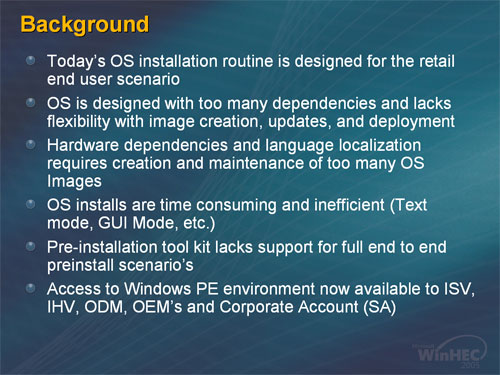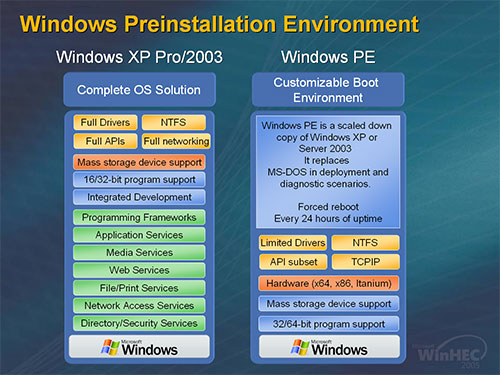WinHEC 2005: Coverage Wrap
by Derek Wilson & Jarred Walton on April 29, 2005 2:00 PM EST- Posted in
- Trade Shows
Longhorn Manufacturing and Installation Features
One of the sessions we attended covered the OEM/business side of Longhorn preparations. Home users don't often think about these issues, but for a company like Dell, installing and configuring the OS on millions of PCs is a critical matter. Some of the basic problems with deployment of Windows are summarized in the following slide.
If none of those items sound particularly important, then you probably haven't dealt with the deployment of a large number of PCs. Hardware dependencies, languages, etc. are all matters that have to be dealt with on a typical assembly line. Longhorn comes with quite a few changes to help their OEM and business partners.

Several of the bullets deal with the management of system images. While ghost utilities have been used in the past, Longhorn will include its own imaging system. The underlying OS has also been componentized in order to facilitate deployment. For example, languages are now an entirely separate component; a single "world wide binary" is used for executables and it simply plugs into whatever language pack(s) the user has installed. The imaging system appeared to be very robust, as only the OS' developer could make it.
The Windows Images (WIM) can contain multiple configurations, and a single file called "unattend.xml" will contain all of the settings for a specific installation. So, rather than having a separate image for Home, Pro, and Media Center, with further images for each system platform, not to mention the various languages... you can get by with a single image! There will still be separate images for x86-32 and x86-64, however, and it wasn't entirely clear (to us) at what point a separate image might be required for different systems. Still, instead of dozens or even hundreds of disk images, the process can be reduced to perhaps two images per machine platform.
Most of this is accomplished using a new tool called Setup Manager. Images can be created, and modifying them can be done by opening the image and adding or deleting files, or simply by dragging and dropping packages onto an existing image. (All of this can alternatively be done at the client level if desired, but that's basically the current way of doing things, so it's nothing new.) If everything goes as planned, an online ordering process could also be integrated with the new imaging tools to create an on-the-fly unattend.xml file for a specific machine. Then on the assembly floor once the hardware is built, the image and configuration file are used to setup the OS and software for a custom PC. The OEM partners at the session looked very interested in the new features, although it's certainly not going to have as big of an impact for home users.
An interesting point that was made during this presentation (and covered elsewhere) is that DOS is going away. We'll still have a command prompt within Windows, but the DOS environment is basically dead. Consider the many businesses and OEMs that currently use DOS to load up a tool like Ghost, along with network drivers for specific platforms. A lot of new hardware - particularly SATA and USB devices - will not be properly supported by DOS. DOS will hit the end of the road on 12/31/05 as far as Microsoft is concerned, and there will be no way to use a DOS executable to start the Windows setup process. What's needed is a new tool to accomplish this task.

Enter Windows PE (Pre-installation Environment), basically a stripped down version of Windows with reduced API support. Like regular Windows, it can be customized to fit the need; it can even be turned back into the full Windows environment if desired, although that's counter productive. (It also has a forced reboot that occurs every 24 hours.) WinPE can easily fit on USB flash devices, coming in at under 64MB for the minimum configuration, although 128MB flash devices may be more appropriate for customized toolsets. Network support among other features will be available, and the same drivers as regular Windows can be used. This should make things easier for driver teams as well as the system builders - at least, that's the plan. We certainly won't miss DOS much - R.I.P. MS-DOS, 2005. Incidentally, WinPE is available for use now (or very soon), and it will work with XP and Server 2003 while we wait on the release of Longhorn.
A few last comments on Longhorn information we picked up at the show. First, Longhorn should install much faster than XP, which is welcome news. The goal is for Longhorn to be installed and ready to use within 15 to 20 minutes of inserting the CD/DVD. DVD? That's right! It's not official yet, but we heard the comment several times that based on the current size of the Longhorn build, DVDs will probably be used. We hope so, as installing from a single DVD sounds a lot better than 3 to 5 CDs. (The current Longhorn image is over 900MB and still missing many drivers, so DVDs really make sense.) The installation process will be faster in part due to less file copying; the image will be extracted to the hard drive, and then enumeration of PnP devices will occur and you're done. With even high-end systems still taking 45 minutes to an hour to complete the XP installation, the thought of getting everything done in less than half that amount of time is definitely appealing.










17 Comments
View All Comments
DerekWilson - Saturday, April 30, 2005 - link
heh ... not even the CPU editor has all the CPUs he needs. We've been passing our one set of dual core processors from both vendors around the globe. :-)JarredWalton - Friday, April 29, 2005 - link
The *official* plan is for Longhorn to be widely available by the holiday 2006 time frame (see day 1 coverage). However, I think XP-64 was supposed to be available over a year ago as well. Call me a skeptic....The point about going next year is that, from what I could tell, certain things are just repeated in slightly updated formats each year. Longhorn was discussed last WinHEC, and the information this time was simply a bit more concrete. There were still quite a few "this isn't yet finalized..." disclaimers throughout the presentations.
I suppose since I'm local to WinHEC (I'm in Olympia, WA), at the very least I'll be going to some of the MS events in the future. We'll have to see how that pans out. Maybe next time I can make it to the Sunday AMD Gaming gig and get a free Athlon 64 4000+? (Yeah, we missed out on that. Not that we don't have lots of hardware already, but having an extra CPU never hurts. Especially when you're not the CPU editor. Heheh)
PrinceGaz - Friday, April 29, 2005 - link
Fascinating. Probably the most relevent event report I've read. The IDF is interesting to see where the hardware is going, but it is the software that we use on a day to day basis, and what Microsoft are planning is likely to impact us the most in the next few years."At the end of the show, while we would definitely say that WinHEC doesn't have the appeal of Computex, E3, or some of the other larger shows, there was still plenty of good information to be found. Will we go again next year?"...
I can't believe you are even wondering whether to go again. Though if Anand is using his Mac all the time now and abandoned PCs, and those of you with PCs have switched from Windows to Linux, then I could understand your hesitation. I jest of course, but what happens with Microsoft is likely to be more important to the PC user than any hardware development, so there is no way you can neglect it.
I thought Longhorn was due out mid-2006, rather than "two years time". Longhron has seemed to be due out in "two years time" for quite a few years now, such that I wonder if it will ever actually arrive. And when it does arrive, will it actually contain many of the improvements originally touted over Windows 2000/XP (such as the central WinFS file-system which they decided would delay Longhorn too long). So are Microsoft officially saying 2007 is Longhorn year now?
Personally I'm in no hurry for Longhorn if it is crippled with DRM restrictions everywhere. The whole pointy of a PC is I can do what I wish with the media I have obtained, whether purchased or from other sources. I would say that being able to view perfect and complete "try before I buy" content has had the main effect with me of making me buy stuff I otherwise wouldn't have considered, rather than simply using it as an alternative to purchasing discs. Content protection that limits consumer choice (even if that choice includes free downloads) is and always has been detrimental to the industry.
JarredWalton - Friday, April 29, 2005 - link
DOS is still in use as a deployment tool. You can still license DOS from MS, but that will cease to be the case as of 2006. I work as an IT guy for a huge corporation, and our PC build process goes like this:1) Boot from floppy.
2) Select PC configuration.
3) Watch Drive Image clone the XP image to the HDD.
4) XP loads up and finishes the device enumeration, joins the appropriate domain, etc.
5) Choose SMS pacakages and wait.... (The final stages of the build process can take as long as an hour or two, depending on the SMS packages that are selected for installation.)
The problem is that getting DOS network drivers as well as support for newer technologies (SATA) is getting more and more difficult. The whole setup process would be more streamlined if HQ personnel didn't have to worry about DOS. I would wager that we'll still continue to use DOS and Drive Image for at least another 5 years, just because that's the way this corporation is, but it's nice to know that eventually they'll be forced to update the process to something that is hopefully faster and more robust.
icarus4586 - Friday, April 29, 2005 - link
"R.I.P. MS-DOS, 2005"This part of the article doesn't make much sense. The huge majority of Windows machines are either 2000 or XP, both of which are NT. NT does not run on DOS. MS-DOS was dead with WinME, and should have been dead far before.
ProviaFan - Friday, April 29, 2005 - link
Interesting stuff... Out of all of it, I found the (U)EFI coverage to be most intriguing, since normally the BIOS is one of the least represented PC components in computer news coverage. ;)stephenbrooks - Friday, April 29, 2005 - link
"One giant Microsoft fest"?? That got me saying "Ewww!" before I started the article. XD Images of hordes of Barney ActiMates™ coming to play with me came to mind.